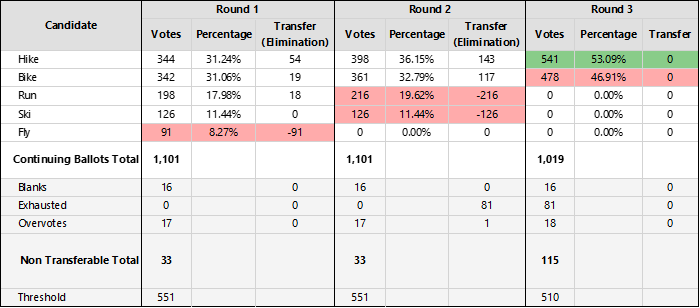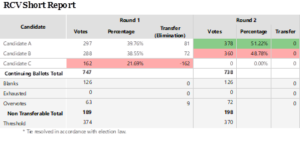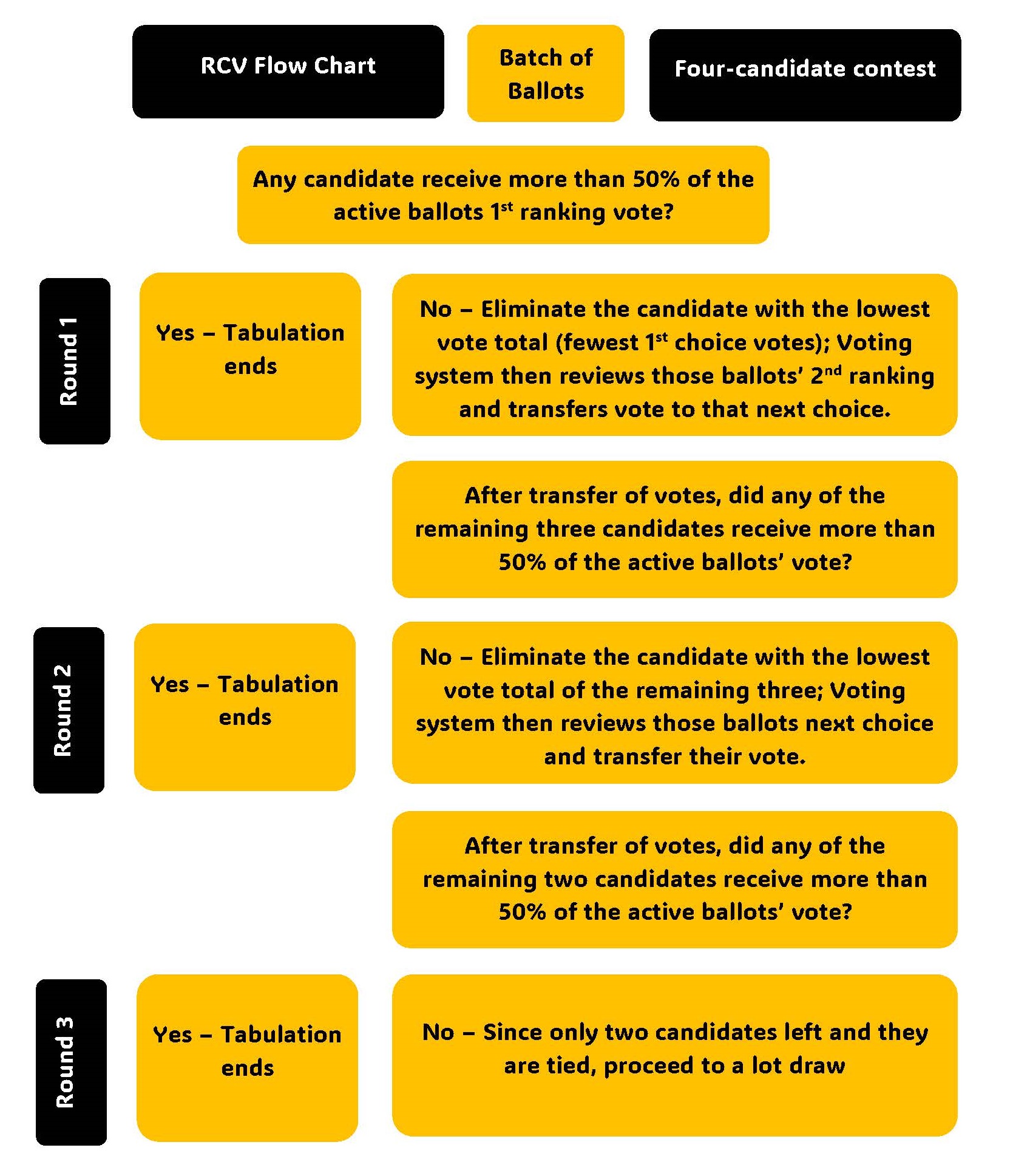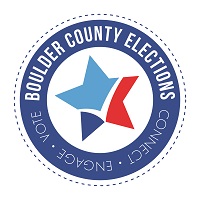This year’s ranked choice voting (RCV) method for electing the City of Boulder’s mayor introduces a different results reporting format than posted for our other contest results. Boulder County Elections will be posting unofficial results starting on election night and official results after certification. Remember, just like with other contests, unofficial RCV contest results will change as we process more and add ballots to the results.
Ranked Choice Voting: Ballot Processing and Results Reporting for City of Boulder Mayor
Overview
RCV Short Report
Below is an example of the RCV Short Report produced by our Voting System. In this sample report, there are five candidates and vote counting went three rounds before a candidate received over 50% of the active ballot votes which ends vote tabulation. The pink-shaded rows indicate the lowest vote total(s) for each Round and the green-shaded area in Round 3 indicates the highest vote total over 50% (Candidate Hike).

How to Interpret the Rounds in the Example Shown
- After first choice ranks were counted in Round 1, no candidate received over 50% of the active ballot votes. First choice counts for each candidate are listed in the Votes column and the Percentage column represents first choice ranks as a portion of the Continuing Ballots Count.
- Since no candidate received more than 50%, tabulation proceeds with an ‘elimination’ of the candidate with the lowest Vote count. The Transfer (Elimination) column lists the vote count transferred to and from each candidate, for example Candidate Fly has 91 first choice ranks eliminated.
- The 91 first choice ranks were redistributed (‘Transfer’) to the next valid choice on each ballot impacted by the elimination of Candidate Fly. Candidates Hike, Bike and Run each received transfers.
- A total of 1134 ballots were submitted for tabulation however the ‘Blanks’ and ‘Overvotes’ represent ballots without valid rankings, resulting in a total of 1,101 ‘Continuing Ballots’ eligible for counting.
- Blank (16) and Overvote (17) ballots are counted as ‘Non-transferable Total’.
- Note the increased Votes for Candidates Hike, Bike and Run. The Votes count for each is the 1st choice rank count from Round 1 plus the 2nd choice count transferred from Candidate Fly’s elimination.
- Again, no candidate received over 50% of the votes on Continuing Ballots (active) counted and there was a ‘batch elimination’ or two candidates eliminated.
- Batch elimination occurred because the Vote total combined for the two candidates with the lowest Vote totals was less than the next highest Vote total – 216+126 is less than 361 Candidate Bike received.
- The 216 votes for Candidate Run and 126 for Candidate Ski were redistributed to the next choice on each ballot impacted by the elimination. In this case Candidates Hike and Bike each received vote transfers.
- Also note, that after Round 2 tabulation, 81 ballots were ‘Exhausted’ meaning all candidates on these ballots have been eliminated.
- The ‘Continuing Ballots Total’ and ‘Threshold’ values for Round 3 both decreased due to the exhausted ballots from the previous Round which are no longer active in tabulation.
- Note the increased Votes total for Candidates Hike and Bike from Round 2. The Votes count is the Round 2 Votes plus Transfers.
- In this round, Candidate Hike received over 50% of the Continuing Ballots vote count – the threshold to reach over 50% coming into Round 3 is 510 votes and Candidate Hike total is 541.
- Tabulation ends when a candidate receives over 50% of the active ballot vote count.
- In the final Round of tabulation, if a candidate reaches the Threshold required, the row will be shaded in green as illustrated in Round 3 of this report example.
The sample report and our language above includes some terminology that may be new to voters. The following is a description of this terminology.
RCV Report Terminology
A Round is a unit of vote counting. In Round 1, 1st choice ranks are counted, and candidate elimination occurs if no candidate receives over 50% of the active ballot votes. In Round 2, on ballots where the 1st choice was eliminated, votes are transferred and added to the 2nd highest ranked candidate vote total, and the over 50% threshold is evaluated. Candidate elimination and vote transfer continues until a candidate has over 50% of the active ballot votes. Note, a candidate may receive over 50% of the active ballot votes in Round 1 or counting may progress through subsequent rounds before the threshold is reached. The maximum number of rounds in a single-winner RCV contest is the number of candidates minus 1. For example, if there are 4 candidates in the contest, the maximum number of rounds is 3.
It is the same as a Continuing Ballot. A ballot that is properly marked with 1st choice and other choices ranked so ballot is active through all rounds of tabulation.
A ballot that does not count for any candidate, e.g. contest not marked by the voter, ballot choices exhausted due to candidate elimination (lowest vote total, overvote). For example, if only 1st and 2nd choices are marked on the ballot and those candidates are eliminated before tabulation ends, the ballot will become inactive since there are no more choices to count.
In a round of tabulation, candidate with lowest vote total is eliminated.
Batch elimination only occurs when the Vote total combined for the two candidates with the lowest Vote totals is less than the next highest Vote total.
Number of ballots that include a valid choice ranking for a continuing candidate. Also referred to as ‘Active’ ballots.
Number of ballots that do not have any choices ranked for the contest.
Number of ballots that no longer have any valid choices ranked. A ballot may be exhausted if the candidates ranked are eliminated before tabulation ends, or if there are no valid remaining choices due to undervote, overvote, duplicate or skipped ranking.
If the voting system determines that any of the following exist, a bipartisan team of election judges adjudicates the ballot and directs the voting system how to interpret the ballot markings. The election judges follow the Colorado Secretary of State – Voter Intent Guide – RCV Addendum in making their determination.
Colorado Election rule identifies the following RCV-specific ballot marking exceptions:
- Overvote (multiple votes in a column): Invalidates the overvoted rankings and all lower rankings marked for that contest.
- Duplicate ranking (multiple votes in a row): Candidate is credited with the highest-ranking marked; other rankings for that candidate are ignored.
- Skipped ranking: For example, marking 1st and 3rd choices, no second choice; choices after the skip are ignored.
On the report, this total represents the sum of the Blanks, Exhausted and Overvote ballot counts- ballots in the Round that have no valid ranking to be counted. As counting continues past Round 1, the Non-transferable Total count may increase. In the sample report, notice that the count of Exhausted and Overvote ballots increased in Round 3, therefore the Non-transferable Total increased from 33 to 115.
This is the number of votes required in the Round to reach over 50% of the active ballots. If as in the sample report, the number of Continuing Ballots decreases, the Threshold number will also decrease. Notice the decrease of both numbers in Round 3 of the sample report.

RCV Visualization Tool
On election night, we will be using an open source visualization tool to display the results in addition to the RCV Short Report.
With each set of results posted, the tool will display the number of rounds and the vote totals. The public will be able to use the tool and click on the rounds (if applicable) to see how the votes were transferred to a ballot’s next choice. In this example, it shows what Round 4 looked like for this particular contest (Virginia GOP convention primary).
RCV Ballot Processing / Election Results - Frequently Asked Questions
In a four-person race, the voting system will perform a maximum of three “instant run-off” rounds of tabulation. Thus, it is technically accurate that the voting system would never count a ballot’s 4th choice. However, according to Colorado election law, we must provide in our ballot design the same number of choices as there are candidates (or we may limit choices to the maximum allowed by the voting system with a minimum of three required).
The City of Boulder mayoral race is a single winner contest and an instant runoff voting type of RCV.
If a recount is triggered (or requested with payment), Boulder County Elections will follow existing recount procedures as described in Statute and Rule, and as followed in previous recounts.
- In accordance with CRS 1-10.5-101, Boulder County Elections will calculate the percentage difference between the candidates with the highest and next highest vote totals in the final round. Just as in other contests, this vote difference would only be reviewed after results certification occurs (November 28). See Ballot Processing Election Night & Beyond for more information on recounts.
- This process would include re-adjudicating all RCV ballots and re-tabulating all Rounds (since changes in scanning (if re-scanned) or adjudication could alter the results of a round.

As an example, shown here is an RCV Short Report with the Final Round is Round 2. The difference between the highest vote and next highest vote total is 18. As a percentage of the highest vote total this comes to 4.76% (378-360=18. 18/378=.0476), which does not trigger a recount as it is not less than or equal to one half of one percent.
RCVis is open-source Ranked-Choice Voting Visualization software used by several other state and local governments to share RCV contest results.
RCVis offers an interactive view of contest results as well as different graphical views and supplements to RCV pdf report to convey contest tabulation logic and vote counting results.



